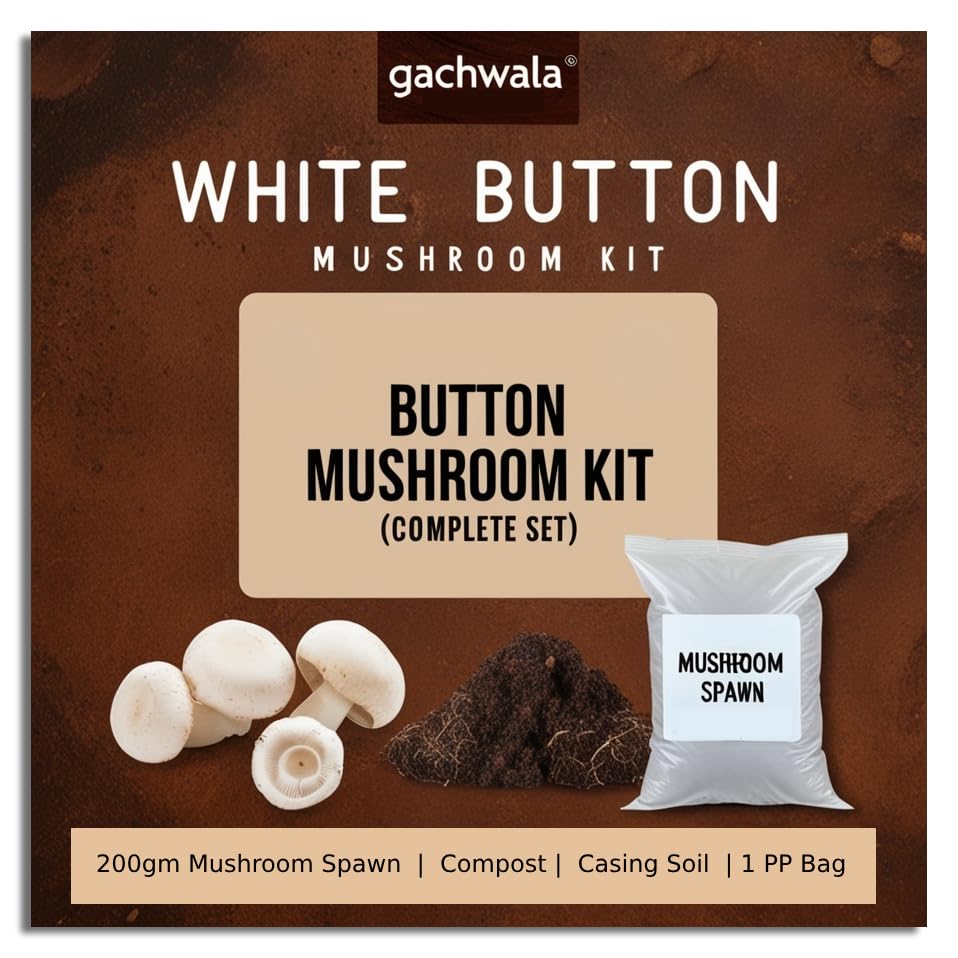Introduction:
Mushroom farming is centuries from dense forests where wild mushrooms have fascinated humans for varieties grow, to modern kitchens where they are used to create delicious dishes, mushrooms have found a place in our culture, cuisine, and even medicine.
These precious fungi are not just a delicious ingredient, but play an important role in nature, helping to decompose waste materials and recover nutrients.
Whether you’re drawn to their earthy flavor, thrilled by their health benefits, or curious to learn about their complex life cycle, exploring the world of mushrooms opens the door to a rich and rewarding experience.
In this blog, we’ll discuss mushroom farming in detail from their history and types to how you can grow.

Table of Contents
Reproduced by spores:
Mushroom farming instead of seeds,mushroom produced spores, which are dispersed by wind and other means to start new fungal growth.
How to sow mushrooms:
Wheat or grain husk is required to grow mushrooms. Calcium ammonium nitrate is used in the husk and then mushroom seeds (spawn) are put in it. 10 kilos of husk grow kit is prepared from 1 kilo of mushroom seeds.

What are the steps for mushroom farming:
Preparing compost :
For mushroom farming to make mushroom compost, agricultural waste, especially wheat husk, animal manure (like cow, horse and epilepsy manure) is mixed with gypsum powder and is done by keeping in mind the temperature and moisture. In this process, after properly heating the animal waste, a mixture is prepared which is then spread on the soil, in which the silt animals break down the manure.
The detailed description of preparing compost is as follows:
Collecting all the essential commodities:
- Wheat husk
- Animal manure
- Gypsum
Preparing the ingredients:
- Soaking the grain
- Crushing the grain
- Mixing grain and gypsum
It takes 28 days for the fertilizer to be prepared using scientific method for mushroom farming:
0 days:
Spread the wet straw evenly to form a layer Once mixed well, stack the material into piles measuring 5 feet in height and 5 feet in width, with the length adjusted as needed. Within 24 hours of forming the pile, the internal temperature will begin to rise, eventually reaching between 70°C and 75°C.
Once mixed well, stack the material into piles measuring 5 feet in height and 5 feet in width, with the length adjusted as needed. Within 24 hours of forming the pile, the internal temperature will begin to rise, eventually reaching between 70°C and 75°C.
1st turn over (6th days):
The outside of the pile remains open and dry, which prevents compost from decomposing efficiently. To correct this, the pile is turned over to bring it back to the proper temperature.
During this process, add 3 kg of FYM, 1.2 kg of urea and 15 kg of bran to the mixture. After this, recreate the heap in the same way as it was originally created on day zero.
2nd turn over (10th days):
take out one foot of compost from outside the compost heap. sprinkle water on it and put it on the middle of the heap while turning it.
3rd turn over (13th days):
Turn the compost for the third time in the same manner as you did the second time. Sprinkle water lightly on the dry outer surface of the compost to maintain the proper moisture level – make sure it is neither too wet nor too dry. At this stage, mix 30 kg of gypsum evenly into the compost.
Break down the manure pile in the same manner as was done on the tenth day during the second turning, and then reconstruct the heap to its original size.
4th turn over (16th days):
The compost heap should be turned to bring it back to its original form, and the correct moisture level should be maintained in the compost. Apart from this, spray insecticide at the rate of 0.5 ml per liter of water.
5th turn over (19th days):
spray farmiling 4% around.
6th turn over (22th days):
spray 4% farmalin solution arround.
7th turn over (25th days):
Once again spray 4% formalin solution around the area. Smell the compost – if you smell ammonia, mix and turn the compost thoroughly.
28th days:
After the 7th turning the manure is inspected for ammonia and moisture. if there is no smell of ammonia in the manure and the moisture is also in proper amount then the manure is ready for sowing.
Mushroom spawning:
To sow seeds weighing 750 grams to 1 kilogram, around 100 kilograms of compost manure is needed. In this technique, the spawn is usually blended directly into the soil.
1.Spot spawning-
compost is baled and spawn is added.
2.Surface spawning-
In which the spawn is spread over the manure and put 3-5 cm of compost on the upper surface.
3.Layer spawning-
Three or four parts of spawn and manure are prepared and the top layer of compost is prepared.
Filling the prepared manure in polythene begs:
cultivation, in any airy room or iron rod, with the help of strong wood, make scaffoldings one above the other in the direction of the height of the room at a distance of about two feet each. Do not keep the width of the scaffolding more than 4 feet. This work should be started before. Now, 2 days before keeping the bags filled with manure, wash the floor of this room with 2 percent of formiline liquid and spray this mixture on the walls and roof. Immediately after this, close the doors and windows of the room in such a way that the air inside cannot go out.
Once the white button mushroom has been spawned, place 8 to 10 kilograms of mushroom seed material into a polythene bag. Fold the top of the bag like a paper bag to seal it properly.
Ensure that the manure inside the bag does not exceed a height of one foot. Additionally, arrange the bags close together on a stick within the room.
Once sowing is complete, spread the material about 6 inches thick on the stand. In this setup, place a polythene sheet underneath the stand, cover it with newspapers on top, and water the newspapers once or twice daily.
Casing:
mushroom farming Casing soil is a type of soil prepared by mixing 2 years old cow dung manure and loamy soil in equal parts
Suitable mixtures for casing soil are as follows
1. Garden manure (cow dung manure), (loamy soil) (1:1)
2. Cow dung manure, earthworm manure (1:1)
3. Cow dung manure, loamy soil and sand (1:1:1)
4. Coco pit + vermicompost
5. FYM + Coco pit
Prepare of casing mixture:
The sowing period for PET button mushroom farming lasts between 12 to 15 days. The middle section of the substrate spreads within the mine, and its color transitions from brown to a white, fungus-like appearance. During this time, the substrate must be flipped regularly, and considerable effort is required with the machine. Afterward, the BUTTON MUSHROOM buds can be easily harvested.
To eliminate diseases from this mixture, two methods involving Formalin solution are applied. For a 2% Formalin solution, dissolve one liter of 40% active ingredient Formalin in water. This solution is then used to moisten the CASING mixture.
After that the mixture is proper covered by polythene. After this the polythene is removed 24 hours before the process starts. After removing the polythene the mixer is turned upside downside by any mixing machine.
Casing Layering:
After opening the bag filled with Kavak Net, gently press the dung layer to form a ball shape. Then, apply a 3-4 cm thick layer of casing mixture on top. Fold the extra polythene of the bag downwards and put the bag back in the room as before.
During this entire period, the room temperature should be maintained between 20-25°C and the humidity level should be kept at 70-75%.”
Maintenance after casing:
When sweet button mushroom farming, special attention should be paid to completing the casing process. The container should be checked daily to monitor the moisture level, and water should be given as needed. It is advisable to sprinkle water about a week after casing.
Water should be added about a week after the casing process. Once the mesh starts forming a felt-like texture in the casing layer, the room temperature should be reduced from 22-25°C to 15-19°C. This temperature should be maintained consistently for a long time.
Germs and Deases:
IN mushroom farming there is a high incidence of Dipterian Phoroid Gerans and Spring Tails flies.
Prevention:
During the period of 7 days, DDVP or nuvan 0.2 pratishat namak pesticides should be sprinkled in the morning and on the walls, window doors should be closed in the evening and window doors should be opened some time for fresh air.
The button mushroom farming crop should be sprayed from top and bottom at regular intervals of a few days. To control flies, install light traps and use paper traps coated with oil or grease.”
Diseases:
There is a risk of many diseases in Fasal like dry bubble, wet bubble, cobweb green mold or trichoderma, false truffle, olive green mold, brown plaster mold, or bacterial blotch or nematode.
Prevention:
for mushroom farming If there is a water tank, it should be treated with 0.15% bleaching powder from time to time.
If any fungus – be it black, green or yellow – is visible on any bag or compost, carefully cut the polythene at that spot and remove the infected part completely using tweezers.
Then a mixture of Bastian calcium carbonate 1:10 grams should be sprinkled on the place.
After spraying, water should not be poured on that place for 48 hours.
Fruiting and harvesting:
About 12-15 days after applying the casing layer, small black mushrooms start emerging from the compost.
Within four to five days, they turn into small white button mushrooms. When these white mushrooms reach a size of 4-5 cm, they are considered mature and should be harvested by twisting them gently.
Once picked, white button mushrooms should be used immediately.
Production:
Short Process of mushroom farming: 10–14 kg fresh mushroom party is obtained from 100kg compost manure.
Long Process of mushroom farming – 15–20kg of fresh mushroom is obtained per 100kg of compost.
Demand:
200–250kg per kg.
Storage:
After plucking the mushrooms, they should be sorted according to their size.
Wash it with three percent calcium chloride ball, wash it with clean water and then spread it on the cloth. After the excess water dries, make packets of 250 grams and 500 grams and seal them in polythene or poly profilin or fill them in bags and keep them in the refrigerator for seven to eight days.
Value Addition:
Fresh mushrooms find a ready market for sale. Apart from this, various products made from mushrooms such as pickles, chips, biscuits, soup, powder and noodles can be prepared and sold.
Canning remains the most widely used method to preserve white button mushrooms, and canned mushrooms are exported in large quantities to international markets.”
Govt support:
By indian govt No,Ownership land is mandatory required for availing of the benefits of this scheme. the government provides a 90% subsidy, significantly reducing the cost for farmers for mushroom farming.
Loan:
Some govt department provides loan for mushroom farming:
Subsidy:
Government provides a 90% subsidy significantly for mushroom farming.
Conclusion:
Mushroom farming is a “AGRICULTURE BUSINESS” Which is also good option for small and landless farmers.Mushroom farming can increase the income of farmers, and it can be certified with sustainable agriculture bonds.
Vermicompost also an good agricultural business idea for small land farmers.


10 thoughts on “Mushroom Farming”